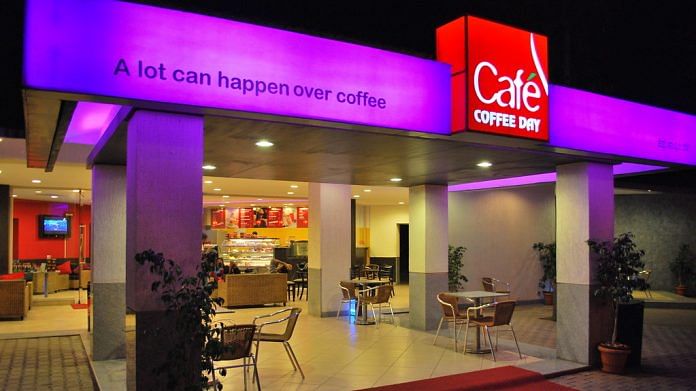New Delhi: In his bleak letter to his company board, Cafe Coffee Day (CCD) founder and owner V.G. Siddhartha, missing in Mangaluru since Monday evening, apologised for having failed to create the “right profitable business model”.
The much-celebrated entrepreneur, battling debt, had resorted to selling his 20.32 per cent stake in the software services firm Mindtree to Larsen and Toubro (L&T) and two CCD affiliates — Coffee Day Enterprises and Coffee Day Trading.
The deal was worth Rs 3,200 crore and helped Siddhartha, the son-in-law of former Karnataka chief minister S.M. Krishna, pare some Rs 2,900 crore worth of debt on the balance sheet of Coffee Day Enterprises, the holding firm of CCD.
Coffee Day Enterprises had a debt of around Rs 6,550 crore as on March 2019. But the enterprise includes over 40 subsidiaries, of which its marquee venture, CCD, didn’t contribute to the debt but instead has been posting profits in the last three fiscals.
CCD, which earned Siddhartha global acclaim, has largely side-stepped the holding company’s crisis and posted a profit of Rs 8.03 crore in the 2016-17 fiscal, which increased to Rs 48.94 crore in FY 2017-18 and further to Rs 60.27 crore in FY 2018-19.
The model that it works on, the result of Siddhartha’s innovative thinking and entrepreneurial mindset, has allowed it to remain the dominant player in the coffee chain business.
From growing his own coffee, setting up outlets in tier 2 cities to maintaining affordable price points, Siddhartha steadily grew CCD into the leader in the sector.
ThePrint explains how the entrepreneur from Chikkamagaluru turned a coffee-based business into a multi-billion-dollar food and beverages conglomerate.
Early mover advantage
The first CCD retail outlet was launched in Bengaluru in 1996. It was meant for customers to sit and surf the internet while enjoying their coffee; hence the name ‘Cafe Coffee Day’.
The brainchild to provide customers with internet, a novelty in the country then, is among the innovations that set CCD on its path to emerge the top player that it is now. In the over two decades since, CCD has become the largest coffee retailer in India with over 1,700 outlets across the country. To put that in perspective, its nearest rival, Barista, has 220 stores. Tata Starbucks has just 146 stores.
Location of outlets
A unique aspect of CCD is the location of its outlets, chiefly concentrated in localities populated by the rich and the middle-class. The map below shows all the CCD outlets currently operating in India along with the percentage of the affluent population surrounding them.
But where CCD stands apart from competitors such as Starbucks, Barista and Costa Coffee, is its focus on Tier 2 cities. While its competitors catered to the economically affluent top 20 per cent of Indian consumers in the metros, CCD strategically sought to reach a wider economic class.
For instance, Ahmedabad, one of Gujarat’s largest and most affluent cities, has no Starbucks or Barista outlets but has 24 CCD outlets. Similarly, Coimbatore, one of Tamil Nadu’s major urban centres, has no Starbucks but has 13 CCD outlets.
Price Point
With its strategy of reaching a wider audience, CCD aligned its pricing model to match the spending power of its consumers. It focused more on attracting footfall to its stores as opposed to higher prices for its coffee-based beverages.
In Delhi, for example, a single cup of cappuccino costs Rs 285 at Starbucks but the same beverage costs Rs 157 at a CCD. The chain also resorted to offering ‘pocket-friendly’ combos such as cold coffee and noodles for Rs 159.
CCD’s own coffee
One way CCD achieved its low pricing point was due to the fact it grows its own coffee. The Chikkamagaluru-based business grows its own coffee in over 20,000 acres of land and is the largest producer of Arabica coffee beans in Asia. Siddhartha himself owns coffee plantations spanning 12,000 acres. This in contrast to other coffee giants that outsource their coffee.
Dominance in terms of revenue
All of this has translated into CCD dominating the market share in terms of revenue.
Coffee Day Global Limited, the CCD subsidiary, earned Rs 1,777 crore in the 2017-18 fiscal. In the same period, the revenue of its nearest competitor Starbucks — a 50:50 venture between Tata Global Beverages and Starbucks Coffee — was Rs 346 crore. Barista, another Indian coffee chain, registered Rs 104 crore revenue in that year.
The hitch in the tale
Despite such mind-boggling figures, CCD has not been immune to the crisis affecting the sector. Dwindling numbers have forced Starbucks and even CCD to shut stores. CCD closed around 90 stores last year.
One reason appears to be stiff competition from newly-launched local chains such as Chaayos and Chai Pe Charcha. It has also prompted CCD to stall its aggressive expansion plans.
Also read: How US is reacting to former Starbucks CEO’s possible run in presidential elections




Poor fellow…. He should have payed hafta to BJP through electoral bonds… Now he is facing all this.